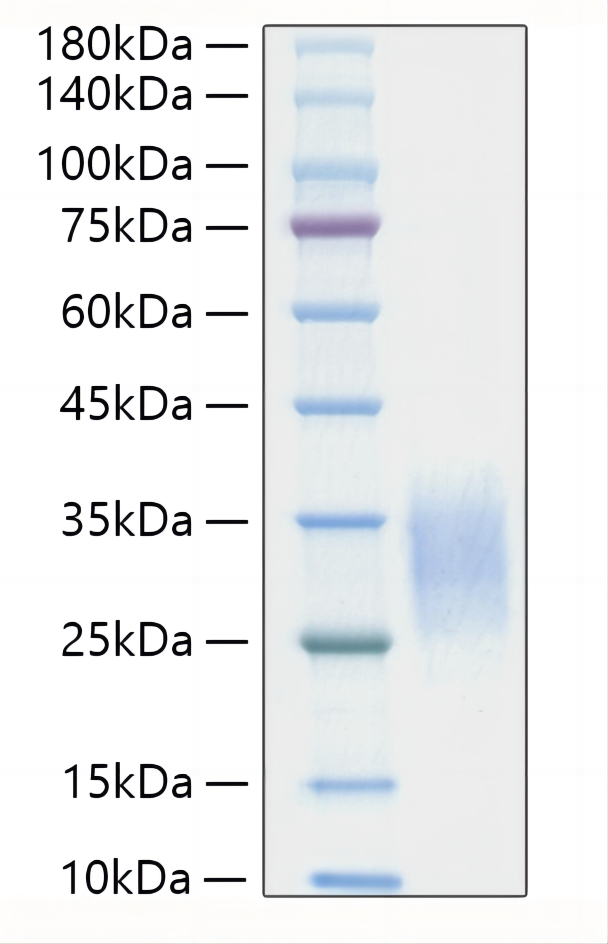Description
Recombinant Mouse IL-19 Protein
The Recombinant Mouse IL-19 Protein is a high-quality recombinant protein designed for murine biological research applications. This protein serves as an essential reagent in mouse model studies, comparative immunology research, and preclinical therapeutic evaluations, enabling scientists to investigate IL-19 biology and its relevance to human disease mechanisms through translational research approaches.
This product (SKU: RPCB1137) is produced using HEK293 cells and features a C-His tag for convenient detection and purification. The protein exhibits a calculated molecular weight of 18.45 kDa with an observed molecular weight of 25-53 kDa under denaturing conditions, achieving ≥ 95 % as determined by SDS-PAGE., ensuring exceptional quality and consistency for research applications.
Key Features
| High Purity by Affinity Chromatography | |
| Mammalian & Bacterial Expression Systems | |
| High lot-to-lot consistency via strict QC |
| Product Name: | Recombinant Mouse IL-19 Protein |
| SKU: | RPCB1137 |
| Size: | 10 μg , 20 μg , 50 μg , 100 μg |
| Reactivity: | Mouse |
| Synonyms: | IL-10C, IL19, IL-19, interleukin 19, MDA1, melanoma differentiation associated protein-like protein, NG.1Melanoma differentiation-associated protein-like protein, ZMDA1interleukin-19 |
| Tag: | C-His |
| Expression Host: | HEK293 cells |
| Calculated MW: | 18.45 kDa |
| Observed MW: | 25-53 kDa |
| Gene ID: | 329244 |
| Protein Description: | High quality, high purity and low endotoxin recombinant Recombinant Mouse IL-19 Protein (RPCB1137), tested reactivity in HEK293 cells and has been validated in SDS-PAGE.100% guaranteed. |
| Endotoxin: | < 0.1 EU/μg of the protein by LAL method. |
| Purity: | ≥ 95 % as determined by SDS-PAGE. |
| Formulation: | Lyophilized from a 0.22 μm filtered solution of PBS, pH 7.4. |
| Reconstitution: | Centrifuge the vial before opening. Reconstitute to a concentration of 0.1-0.5 mg/mL in sterile distilled water. Avoid vortex or vigorously pipetting the protein. For long term storage, it is recommended to add a carrier protein or stablizer (e.g. 0.1% BSA, 5% HSA, 10% FBS or 5% Trehalose), and aliquot the reconstituted protein solution to minimize free-thaw cycles. |
| Storage: | Store at -20℃.Store the lyophilized protein at -20℃ to -80 ℃ up to 1 year from the date of receipt. After reconstitution, the protein solution is stable at -20℃ for 3 months, at 2-8℃ for up to 1 week. |
Interleukin 19 (IL-19) is a member of the IL-10 family of cytokines. The IL-10 family is a class II alpha -helical collection of cytokines that contains two groups, a viral homolog and a cellular homolog group. Within the cellular homolog group, there are two additional groupings, one which uses IL-10 R2 as a signal transducing receptor (IL-10, IL-22 and IL-26), and one which uses IL-20 R2 as a signal transducing receptor (IL-19, IL-20 and IL-24). Mouse IL-19 is synthesized as a 176 amino acid (aa) precursor that contains a 24 aa signal sequence and a 152 aa mature region. Based on human studies, it is expected to be secreted as a glycosylated monomer, 35 - 45 kDa in size. IL-19 is unusual in that it contains seven amphipathic helices. Mature mouse IL-19 shares 69% aa sequence identity with the mature human IL-19, and 85% and 68% aa identity to unpublished Genbank sequences for rat and canine IL-19, respectively. Although mouse IL-19 is active on human cells, human IL-19 is not active on mouse cells. IL-19 expression is limited to activated keratinocytes and monocytes, with a possible contribution from B cells. IL-19 binds a receptor complex consisting of the IL-20 receptor alpha (also known as IL-20 R1) and the IL-20 receptor beta (IL-20 R2). This receptor complex is also shared by IL-20 and IL-24. Notably, IL-19 is reported to actually bind to IL-20 R2, which is generally considered to be only the signal transducing receptor subunit. Functionally, it has been reported that IL-19 both will and will not induce IL-6 and TNF production by monocytes. It does, however, seem to drive T-helper cell differentiation towards a Th2 response, inducing both IL-10 and production of itself.







